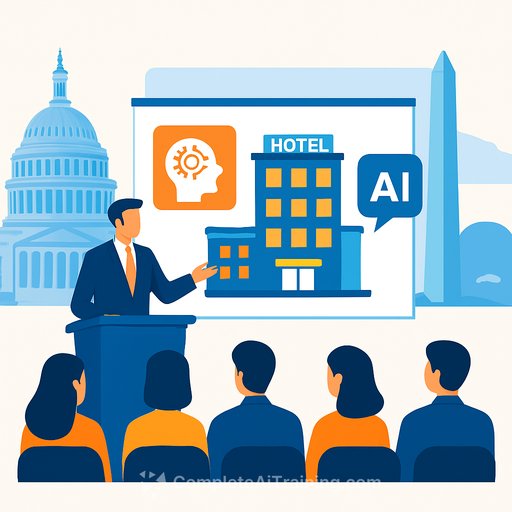Strategic Event Intelligence: Data and AI That Make Events Work Harder for Destinations
At WTM London, senior leaders from tourism, travel-tech, and destination management met behind closed doors to tackle a blunt question: how do data and AI make events deliver clear value for destinations and local communities?
Hosted at the Crowne Plaza Docklands, the session "Strategic Event Intelligence - Data, Impact and the Future of Events Tourism" brought together executives from Mabrian, The Data Appeal Company - Almawave Group, the Global Tourism Resilience Council, JCDecaux, ICF, This is Breeze, Queer Destinations, and destination leaders from across Europe.
The message was straightforward: treat events as a core lever in destination strategy, not a one-off show. Use intelligence to plan smarter, prove impact, and leave a legacy residents can feel.
Key takeaways from the roundtable
- Events build reputation, attract investment, and create community value-when guided by data. With the right inputs, they move from short spikes to consistent outcomes.
- Data should map the full cycle: opportunity sizing, feasibility, demand prediction, execution, and legacy measurement.
- Common frameworks matter. Destinations and organisers need shared definitions for impact, sustainability, and community outcomes.
- Sustainability metrics and predictive analytics will sit at the center of planning and evaluation for authorities and organisers.
- Events work best when embedded in destination-wide strategies with clear governance across public, private, and community partners.
Leaders in the room stressed collaboration over vanity metrics. The goal: align governments, data partners, and operators around purpose, transparency, and long-term impact that reaches residents, not just visitor counts.
What this means for hospitality and events teams
- Forecast demand early: use flight searches, hotel on-the-books, card spend trends, and social interest to size expected attendance and spend.
- Price and package with intent: dynamic room and ticket pricing, shoulder-night packages, and local experiences that increase length of stay.
- Protect operations: workforce scheduling, transport capacity, queue and crowd flow plans based on predicted peaks by hour and zone.
- Target marketing: segment by origin market and interest clusters; track sentiment pre/during/post to adjust messaging in real time.
- Boost local value: set supplier targets (local F&B, makers, venues), inclusive programming (e.g., LGBTQ+ travel needs), and small-business participation.
- Earn community trust: share the plan, monitor resident sentiment, and publish results-good and bad.
Build a practical event intelligence stack
- Inputs: search and booking data (air, rail, hotel), mobility and footfall, payments/card spend, POS, OTA reviews, social and media sentiment, weather, event calendars.
- Core tools: a central data layer, a forecasting model for demand and spend, a sustainability calculator (carbon, waste, water), and an impact dashboard.
- Privacy and ethics: use aggregated, consented data; document methods; share assumptions with stakeholders.
- 90-day sprint: define 5 KPIs, set a baseline from last event, run a pilot for one upcoming event, publish a one-page scorecard afterwards.
Metrics that matter
- Visitor economy: average spend per visitor, length of stay, repeat visitation, off-peak night share.
- Operations: occupancy by daypart, dwell time, queue times, transport load factors, incident rate.
- Community and legacy: resident sentiment, local supplier share, jobs supported, skills training delivered.
- Sustainability: carbon per attendee, energy per venue hour, waste per attendee (and diversion rate), public transport share, accessible and inclusive facilities.
Sustainability and standards
If you want a solid playbook, use established frameworks and keep the math open. ISO 20121 sets a practical management standard for sustainable events. Pair that with destination-level measurement like UN Tourism's work on Measuring the Sustainability of Tourism.
Governance that sticks
- Create a cross-functional squad: tourism board, city ops, venue, transport, hotels, attractions, community reps, and data partners.
- Publish a one-page event thesis: purpose, target audiences, expected outcomes, and how you'll measure them.
- Set decision gates: go/no-go criteria based on feasibility, community feedback, and sustainability thresholds.
- Share results publicly within 30 days: what worked, what didn't, what changes next time.
Next steps for your next event
- Audit: list current data sources, gaps, and who owns them.
- Pilot: apply forecasting and a basic sustainability calculator to one event this quarter.
- Report: agree on five KPIs and publish them, internally and externally.
- Iterate: add channels (card spend, mobility, sentiment) and refine pricing, staffing, and transport plans.
Events can do more than fill rooms for a weekend. With the right data and a clear plan, they grow reputation, lift local business, and build resilience that lasts beyond the closing ceremony.
If you're upskilling your team on AI for event planning and measurement, explore role-based options here: Complete AI Training - Courses by Job.
Your membership also unlocks:






